How to Choose the Right Houseplant: Get It Right Every Time
Choosing the right houseplant for your home can be challenging especially if you are a new plant owner. Like humans, plants have their needs and preferences. One houseplant can grow in totally different conditions than another. Aligning your needs with those of a houseplant is the key to choosing the perfect plant for your home. We have covered how to choose the right houseplant for your home in our article. Read on to discover what it entails.
How to choose the right houseplant for your home
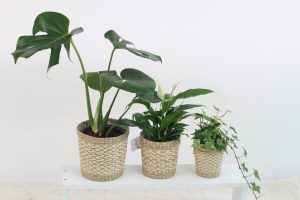
Before you choose a suitable plant for your home, there are several factors you should consider. Here is how to choose a houseplant for your home.
Consider the size of your houseplant
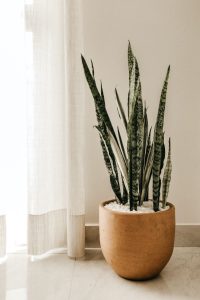
The size of your houseplant matters. Some houseplants can grow to be huge while others remain small. Check the space you have in your home before buying a houseplant.
If you have limited space, a small houseplant would be best. A small houseplant would look great on a coffee table or window sill. Some small houseplants you can consider include:
- Air plants
- Chinese Money plant
- Aloe Vera
- Jade plant
- Lucky Bamboo plant
If your home has ample space, you can opt for a larger houseplant. Avoid buying a large plant if your home doesn’t have enough space. Large plants need enough space to grow and thrive.
The ideal spot for a large houseplant would be a spacious corner. You can grow a large plant in a pot and place it on the floor. You can consider growing large houseplants like:
- Palm plant
- Dragon tree
- Fiddle Leaf Fig
- Monstera plant
- African Milk Tree
Choose a plant that won’t struggle to fit in your space. You might be tempted to squeeze a large houseplant behind furniture or on top of shelves. Doing that will block the plant from getting the adequate airflow it needs to thrive.
How to Choose the right houseplant: Check the growing conditions of your home
You don’t want to buy a plant that will wilt and die due to inadequate lighting or too much humidity. Check the growing conditions of your indoor space before purchasing a houseplant. Different houseplants need varying conditions to thrive. Below are the conditions you should consider.
Lighting
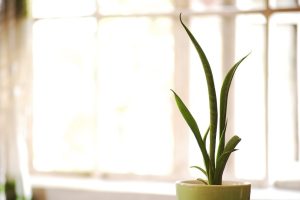
Some houseplants require bright indirect sunlight to survive while others will flourish in shaded conditions. If your indoor space is poorly lit, choosing a low-light plant would be ideal. On the other hand, if you have access to enough lighting, you can select a plant that needs plenty of lighting to thrive.
Some houseplants might not tolerate direct sunlight and you should consider making your space adaptable to your plant. For instance, you can use sheer curtains to protect the plant from direct sunlight. Identifying the lighting conditions of your home helps you narrow down your houseplant choices.
Some of the houseplants that require plenty of light to survive include:
- Aloe plant
- Croton plant
- Jade plant
- Ponytail Pam plant
- String of Pearls plant
If your house doesn’t have enough lighting, you can opt for several low-light plants namely:
- Snake plant
- Cast Iron plant
- ZZ plant
- Pothos plant
- Lucky Bamboo plant
Temperature

Another factor you should consider before purchasing a houseplant is the temperature conditions of your home. Some houseplants need warm temperatures to flourish while others can tolerate low temperatures. If you reside in an area with cold temperatures, you should consider growing a houseplant that can tolerate those conditions.
For instance, houseplants native to arid and semi-arid regions can adapt to extremely cold or warm temperatures. However, you should avoid exposing your houseplants to extremely cold temperatures as they might frost and die.
Some tropical plants need warm temperatures and will die when exposed to extremely low temperatures. Such plants would be best to grow in warm indoor conditions. Mimicking the outdoor growing conditions of a plant is the key to choosing the most ideal houseplant for your home.
Below are several houseplants that need warm temperatures to thrive indoors.
- Umbrella Tree
- Croton plant
- Kalanchoe plant
- Crown of Thorns plant
- Spider plant
Plants that can tolerate cold temperatures include:
- Christmas Cactus plant
- Philodendron plant
- Snake plant
- Jade plant
- Dracaena plants
Humidity

Some houseplants need consistently humid conditions to survive indoors while others cannot tolerate humid conditions. Most Succulents and Cacti thrive in dry conditions while tropical plants require humid conditions to remain healthy.
If your indoor space is dry, you can consider growing low-humidity plants. Try to place your low-humidity houseplants away from high-humidity areas like the bathroom or kitchen.
On the other hand, if you can maintain constant humidity in your home, you can choose a high-humidity houseplant. You can increase humidity indoors using a humidifier. Alternatively, you can fill a jar with water and pebbles to increase humidity levels. If you opt to grow high-humidity houseplants, keep them away from air vents and drafty windows or doors.
There are several high-humidity houseplants that you can choose from including:
- Ferns
- Prayer plants
- Monstera plants
- Spider plants
- Parlor Palm plant
If you opt for less fussy plants that can thrive in low-humidity conditions, you can choose the following plants.
- Jade plant
- Aloe Vera plant
- Snake plant
- Philodendron
- Cacti plant
Water
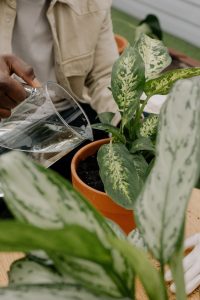
Water is another important growing condition that most houseplants need to survive. Some houseplants need frequent watering compared to others. Some houseplants can even tolerate drought.
If you reside in arid areas where water can be problematic, you can choose to grow drought-resistant houseplants like cacti and succulents. If you have access to ample water, you can opt to grow tropical plants.
Some plants require special attention when it comes to watering. For instance, a houseplant like Calathea is sensitive to tap water and requires distilled water to thrive. Before selecting a houseplant, ensure you can deliver the watering needs it requires.
Some of the houseplants with low watering requirements include:
- Snake plant
- Pothos plant
- ZZ plant
- Ponytail Palm plant
- Aloe plant
Houseplants that require plenty of water to thrive include:
- Begonia plant
- African Violet plant
- Philodendron plant
- Chinese Evergreen plant
- Banana tree
Other houseplants that are sensitive to chemicals present in water include:
- Peace Lily plant
- Calathea plant
- Maranta plant
- Spider plant
- Dracaena plant
How to Choose the right houseplant: Consider your pets and children

Most houseplants are toxic to cats, dogs, and even humans. If you have pets or small children in your home, you should consider choosing non-toxic houseplants or choosing a location that your pets or children can’t access. Some houseplants contain toxic substances that can be toxic to pets when ingested.
Other houseplants cause skin irritation when touched. When growing toxic houseplants indoors, you should be extra careful. Try to place them on high shelves or in rooms that your pets or children can’t access. When handling toxic houseplants, be sure to wear gloves to prevent skin irritation. Below are some toxic houseplants you should be cautious with.
- Dumb Cane plant
- English Ivy plant
- Philodendron plant
- Sago Palm plant
- Caladium plant
- Snake plant
- Pothos plant
How to Choose the right houseplant: Check the level of care the plant needs

Before selecting a houseplant, compare the level of care it needs against what you can provide. You probably have a busy schedule and you can only grow an easy houseplant that doesn’t require too much attention. For a beginner, easy houseplants would be best. If you are a pro gardener without a busy schedule, you can grow houseplants that require extra attention.
Some houseplants need frequent watering, different levels of lighting, special soil mixes, and more to flourish. Other plants don’t need special attention apart from occasional watering. Identifying the level of care a houseplant needs helps you select a suitable plant that matches your lifestyle. Some of the easiest houseplants you can grow include:
- Snake plant
- Aloe plant
- Cast Iron plant
- Dieffenbachia
- Chinese evergreen
If you can provide extra care to your houseplants, you can opt to grow the following plants.
- Alocasia plant
- Calathea plant
- Caladium plant
- Moth Orchid plant
- Croton plant
How to Choose the right houseplant: Examine the plant for pests and diseases

Pests and diseases can kill your plant even before you enjoy its greenery. Make sure you inspect your houseplant for common pests and diseases. Some common pests that invade most houseplants include aphids, mealybugs, scales, spider mites, and more.
Most houseplants are also susceptible to diseases such as root rot, fungal leaf spots, bacterial leaf spots, powdery mildew, mold, and others. If your houseplant is free of pests and diseases, ensure you take proper care of it to prevent such issues. Avoid overwatering your plant and occasionally inspect the plant for pests.
How to Choose the right houseplant: Select a suitable container with drainage holes
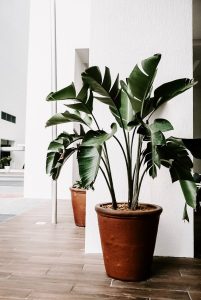
How to choose the right houseplant also involves selecting a suitable container. Your houseplant will grow over time and needs a container that can accommodate its size. Select a container with ample drainage holes to prevent waterlogging.
For fast-growing plants, you can choose a larger container. Some slow-growing houseplants prefer to be pot-bound and won’t require too large containers. Terra cotta containers improve drainage and would be suitable for houseplants like cacti that require little moisture to thrive.
In addition to selecting the right pot for your plant, choose the right soil too. Ensure the soil is fast draining and favorable for your plant.
How to choose a houseplant should be the first topic of research before you settle on a particular houseplant. Discover the amount of space you have in your home. Will it be enough for your large houseplant? If not, choose a smaller one. Also, learn what a houseplant needs to thrive and compare the requirements to what you can offer. If you need more assistance, reach out to us today.
